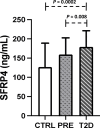Role of secreted frizzled-related protein 4 in prediabetes and type 2 diabetes: a cross sectional study
- PMID: 38834984
- PMCID: PMC11149217
- DOI: 10.1186/s12902-024-01613-5
Role of secreted frizzled-related protein 4 in prediabetes and type 2 diabetes: a cross sectional study
Abstract
Background: Type 2 diabetes (T2D) has become an epidemic. Delays in diagnosis and as a consequent late treatment has resulted in high prevalence of complications and mortality. Secreted frizzled-related protein 4 (SFRP4), has been recently identified as a potential early biomarker of T2D related to obesity, due to its association with low grade inflammation in adipose tissue and impaired glucose metabolism. We aimed to evaluate the role of SFRP4 in prediabetes and T2D in a Mexican population.
Methods: This was a cross-sectional study that included 80 subjects with T2D, 50 subjects with prediabetes and 50 healthy individuals. Fasting SFRP4 and insulin concentrations were measured by ELISA. Human serum IL-10, IL-6, IL-1β and IL-8 levels were quantified by flow cytometry. Genotyping was performed by TaqMan® probes.
Results: Prediabetes and T2D patients had significantly higher SFRP4 levels than controls (P < 0.05). In turn, prediabetes subjects had higher SFRP4 concentrations than control subjects (P < 0.05). Additionally, the prediabetes and T2D groups had higher concentrations of proinflammatory molecules such as IL-6, IL-1β and IL-8, and lower concentrations of IL-10, an anti-inflammatory cytokine, than controls (P < 0.001). The serum SFRP4 concentrations were positively correlated with parameters that are elevated in prediabetes and T2D states, such as, HbA1c and homeostasis model assessment insulin resistance (HOMA-IR), (r = 0.168 and 0.248, respectively, P < 0.05). Also, serum SFRP4 concentrations were positively correlated with concentrations of pro-inflammatory molecules (CRP, IL-6, IL-1β and IL-8) and negatively correlated with the anti-inflammatory molecule IL-10, even after adjusting for body mass index and age (P < 0.001). The genetic variant rs4720265 was correlated with low HDL concentrations in T2D (P < 0.05).
Conclusions: SFRP4 correlates positively with the stage of prediabetes, suggesting that it may be an early biomarker to predict the risk of developing diabetes in people with high serum concentrations of SFRP4, although further longitudinal studies are required.
Keywords: Biomarker; Prediabetes; SFRP4; insulin resistance; Type 2 diabetes.
© 2024. The Author(s).
Conflict of interest statement
The authors declare no competing interests.
Figures



Similar articles
-
Associations of cardiac stress biomarkers with incident type 2 diabetes and changes in glucose metabolism: KORA F4/FF4 study.Cardiovasc Diabetol. 2020 Oct 16;19(1):178. doi: 10.1186/s12933-020-01117-1. Cardiovasc Diabetol. 2020. PMID: 33066780 Free PMC article.
-
Relationship between serum secreted frizzled-related protein 4 levels and the first-phase of glucose-stimulated insulin secretion in individuals with different glucose tolerance.Endocr J. 2015;62(8):733-40. doi: 10.1507/endocrj.EJ15-0212. Epub 2015 Jul 4. Endocr J. 2015. PMID: 26041556
-
Secreted Frizzled-Related Protein 4 (SFRP4) is Elevated in Patients with Diabetes Mellitus.Horm Metab Res. 2016 May;48(5):345-8. doi: 10.1055/s-0041-111698. Epub 2016 Feb 16. Horm Metab Res. 2016. PMID: 26882051
-
Secreted frizzled-related protein 4 and its implication in obesity and type-2 diabetes.IUBMB Life. 2019 Nov;71(11):1701-1710. doi: 10.1002/iub.2123. Epub 2019 Jul 13. IUBMB Life. 2019. PMID: 31301214 Review.
-
Exploring the Prevalence of Undiagnosed Prediabetes, Type 2 Diabetes Mellitus, and Risk Factors in Adolescents: A Systematic Review.J Pediatr Nurs. 2020 Jan-Feb;50:94-104. doi: 10.1016/j.pedn.2019.09.025. Epub 2019 Nov 28. J Pediatr Nurs. 2020. PMID: 31786470
Cited by
-
Triglyceride-glucose index: a potent predictor of metabolic risk factors and eating behavior patterns among obese individuals.BMC Endocr Disord. 2025 Mar 18;25(1):71. doi: 10.1186/s12902-025-01887-3. BMC Endocr Disord. 2025. PMID: 40098017 Free PMC article.
References
-
- International Diabetes Federation. IDF Diabetes Atlas. 10th edition. Brussels, Belgium; 2021.
-
- 2 Classification and diagnosis of diabetes: standards of Medical Care in Diabetes-2022. Diabetes Care. 2022;45(Suppl 1):S17–38. - PubMed
MeSH terms
Substances
LinkOut - more resources
Full Text Sources
Medical
Molecular Biology Databases
Research Materials
Miscellaneous

